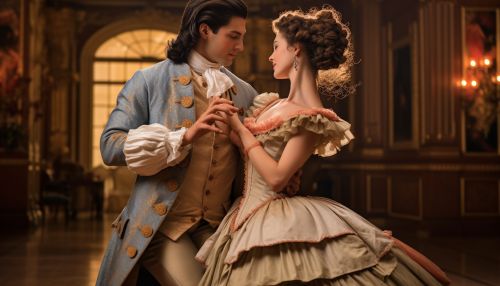Minuet
Overview
The minuet is a social dance of French origin for two people, usually in 3/4 time. The word was adapted from Italian minuetto and French menuet, possibly from the French menu meaning slender, small, referring to the very small steps, or from the early 17th-century popular group dances called branle à mener or amener.
The term also describes a musical composition written in the same time and rhythm, though when referring to the musical piece it is spelled by some as "minuetto". The name may refer to the short steps, pas menus, taken in the dance, or else be derived from the branle à mener or amener, popular group dances in early 17th-century France.
History
The earliest written reference to the minuet is from the book of the French philosopher Montaigne's in 1580. In that period, it was a lively social dance performed by the nobility in balls. The minuet was traditionally said to have descended from the branle, and this was stated as fact as late as the early 20th century. However, there is no evidence to support this claim, and it is unlikely on historical and musical grounds.


Structure and Style
The minuet is often associated with sophistication and elegance; it epitomizes the classical spirit of balance and symmetry. Danced with a sliding step, it was introduced to the ballrooms of Europe in the 17th century and was danced aristocratically into the 19th century.
The minuet is usually in binary form (AABB), with each section typically repeated. The second section often extensively uses elements from the first section and further develops them. This is known as rounded binary form.
Musical Minuet
In the Baroque period, the minuet was frequently used as a third movement in four-movement non-vocal works such as sonatas, string quartets, and symphonies, although in this context it would not accompany any dancing. The Italian term minuetto is also used to designate the musical form.
Influence and Legacy
The minuet was replaced in the 19th century by the waltz. Today, the minuet is usually taught as the first of the social dances, in order for students to get the feel of a ballroom dance and to learn to move lightly and swiftly across the floor. The minuet, however, is still danced in society balls and at historical reenactments.
